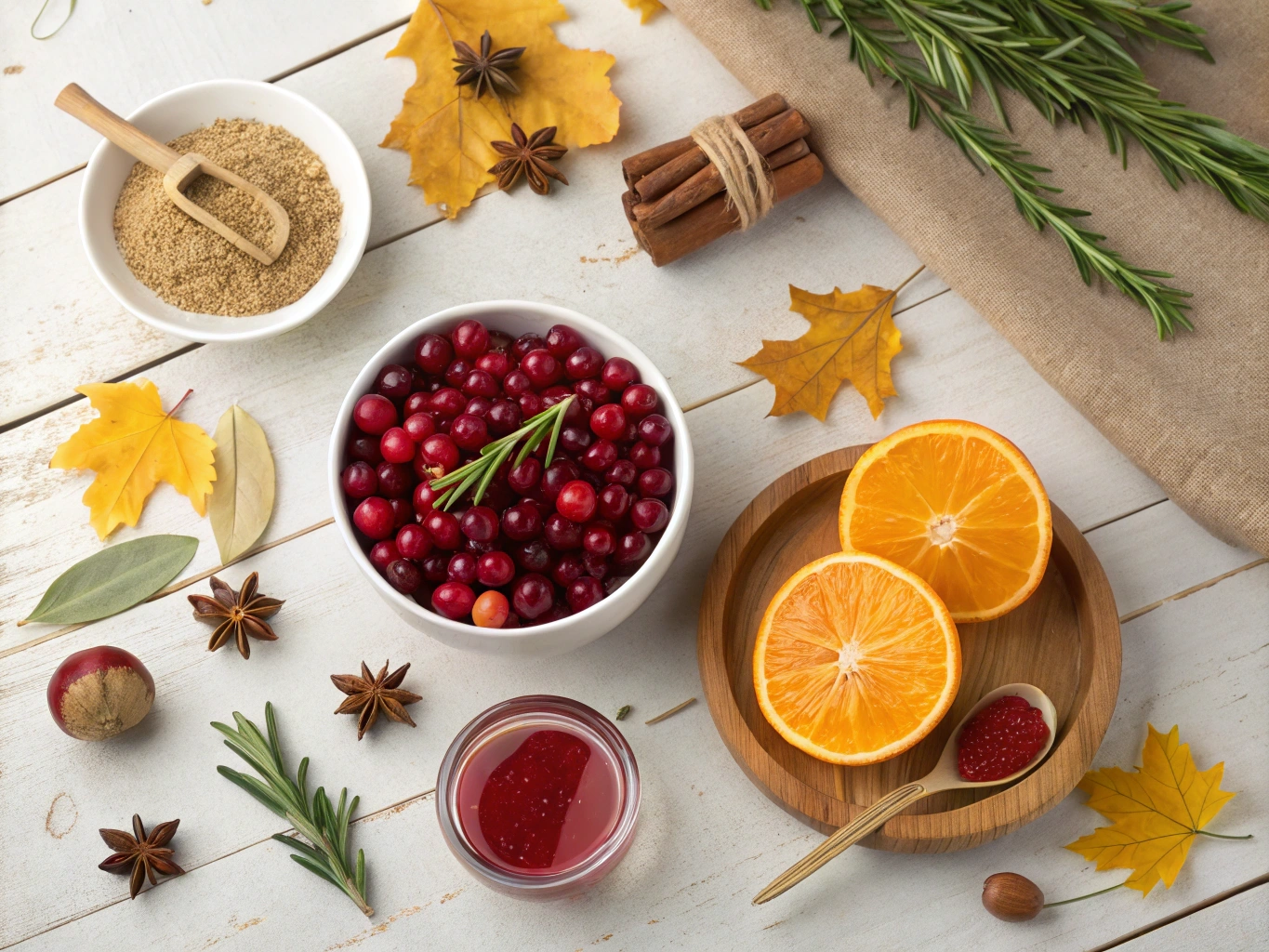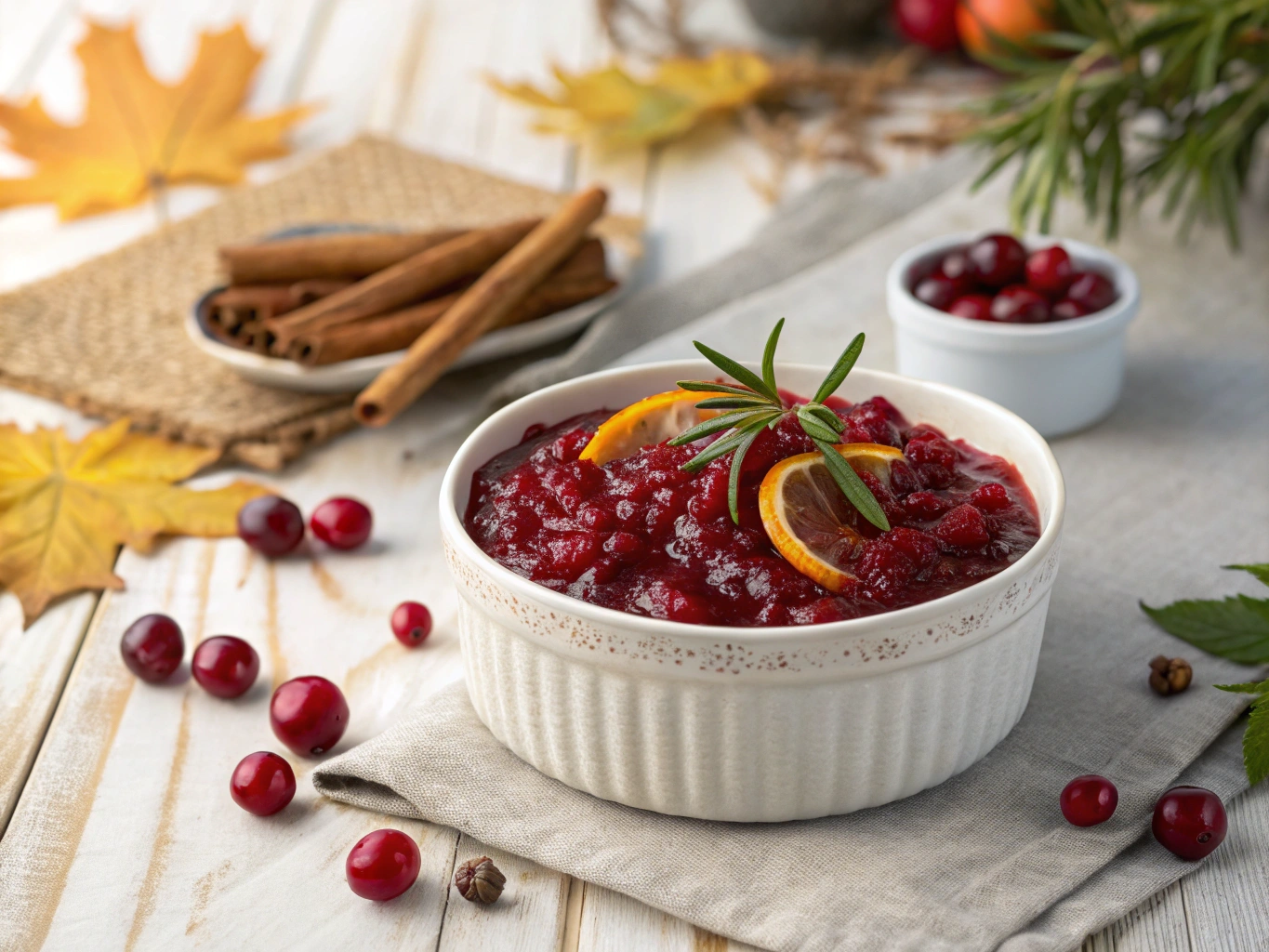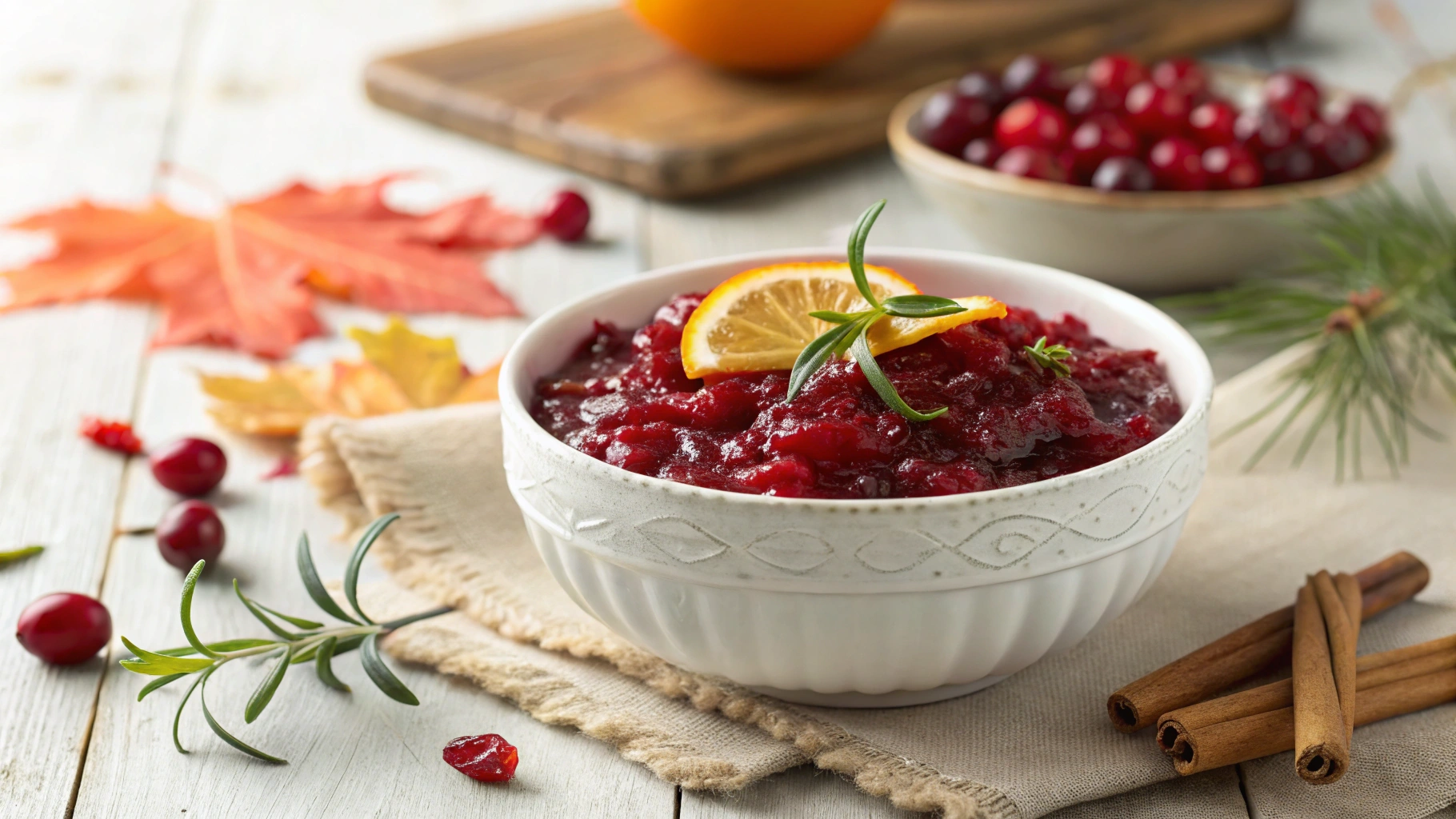The first time I made homemade cranberry sauce, the vibrant pop of those ruby-red berries against my wooden spoon changed my holiday table forever. That bright, tangy flavor bears no resemblance to the canned variety many of us grew up with—and it takes just minutes to create a tradition your family will request year after year.
- Bist Amazon Picks:
Let’s face it—that ridged cylinder of jellied cranberry sauce sliding onto a serving dish might evoke nostalgic memories, but it hardly showcases the true potential of this remarkable berry. With just a handful of ingredients and fifteen minutes of active cooking time, you can transform your holiday spread with a fresh cranberry sauce that guests will rave about long after the meal ends.
Why Fresh Cranberry Sauce Makes All the Difference
Close your eyes and imagine two scenarios: In one, a perfectly molded cylinder of deep burgundy jelly sits untouched on a small plate, fork marks barely making a dent in its surface. In the other, a glistening, jewel-toned sauce studded with whole berries catches the light, its aroma of citrus and warm spices wafting across the table.
Fresh cranberry sauce delivers a sensory experience that processed versions simply cannot match. The berries maintain their integrity, creating a delightful texture that ranges from silky smooth to pleasantly chunky, depending on your preference. Each spoonful delivers a perfect balance of sweet and tart notes that awaken your palate between bites of richer holiday fare.
Beyond the superior flavor profile, preparing your own cranberry sauce offers notable health advantages. Fresh cranberries pack a serious nutritional punch, containing high levels of vitamin C, fiber, and antioxidants. When you make your sauce from scratch, you control the ingredients—meaning you can adjust sugar levels, avoid preservatives, and customize to accommodate dietary restrictions.
Perhaps most significantly, homemade cranberry sauce allows for personalization. Whether your family prefers a citrus-forward recipe, enjoys warm baking spices, or appreciates unexpected additions like jalapeño or bourbon, crafting your own sauce permits endless experimentation to create your signature holiday companion.
Essential Ingredients for Perfect Fresh Cranberry Sauce
Selecting the Best Cranberries
The foundation of any outstanding cranberry sauce begins with selecting quality berries. When shopping, look for cranberries that appear plump, firm, and vibrantly colored. Fresh cranberries should bounce when dropped—a time-honored test that reveals whether they’ve reached peak ripeness.
Cranberry season typically runs from early October through December, making them perfectly timed for holiday cooking. If you discover particularly beautiful specimens at your farmers’ market or grocery store, consider purchasing extra bags, as fresh cranberries freeze beautifully for up to a year. Simply toss the entire bag into your freezer without washing first.
For those moments when fresh cranberries prove elusive, frozen cranberries work wonderfully as a substitute. No need to thaw them before cooking—simply add them directly to your pot and extend the cooking time by approximately two minutes.
Sweetener Options and Flavor Balancing
Cranberries possess an intensely tart profile that requires sweetening to create a palatable sauce. Traditional recipes call for granulated sugar, which dissolves easily and provides reliable results. However, numerous alternatives offer different flavor dimensions:
Maple syrup imparts a woodsy complexity that pairs beautifully with traditional Thanksgiving dishes. Honey adds floral notes and slightly modified texture. Brown sugar contributes molasses undertones that complement warm spice additions.
The perfect balance between sweet and tart remains highly subjective. Begin with a ratio of ¾ cup sweetener to 12 ounces of cranberries, then adjust upward according to your preference. Remember that the sauce will taste slightly less sweet once cooled, so taste test while warm.
Liquid Components
Every cranberry sauce requires some liquid to begin the cooking process. Water serves as the most neutral option, allowing the cranberry flavor to shine unobstructed. For additional complexity, orange juice introduces complementary citrus notes while still allowing the cranberry to maintain its starring role.
The amount of liquid significantly impacts your sauce’s final consistency. Traditional recipes recommend one cup of liquid per 12-ounce bag of cranberries, yielding a spoonable sauce. Reduce the liquid by a quarter cup for a thicker, more substantial texture.
Adventurous cooks might consider substituting a portion of the liquid with spirits such as port wine, Grand Marnier, or bourbon. These additions contribute sophisticated undertones that elevate your cranberry sauce beyond ordinary expectations.
Table: Basic Fresh Cranberry Sauce Ingredients

| Ingredient | Amount | Notes |
|---|---|---|
| Fresh cranberries | 12 oz (1 standard bag) | Rinsed and sorted |
| Granulated sugar | 3/4 to 1 cup | Adjust to taste |
| Water or orange juice | 1 cup | For cooking berries |
| Orange zest | 1 tablespoon | Optional but recommended |
| Vanilla extract | 1/2 teaspoon | Optional flavor enhancer |
| Cinnamon | 1/4 teaspoon | Optional warming spice |
5 Easy Steps for the Perfect Fresh Cranberry Sauce
Step 1: Prepare Your Ingredients
Begin by emptying your cranberries into a colander and rinsing thoroughly under cool water. Take a moment to sort through the berries, removing any stems or shriveled specimens. This quick quality check ensures optimal flavor and texture in your finished sauce.
For those planning ahead, this preparation step can be completed up to two days before cooking. Simply store your washed, sorted cranberries in an airtight container in the refrigerator until ready to use.
One crucial observation: discard any soft or bruised berries, as these may introduce off flavors to your sauce. The perfect cranberry feels firm to the touch and retains its round shape.
Step 2: Combine Liquid and Sweetener
In a medium saucepan, combine your chosen liquid (water or juice) with your sweetener. Place over medium heat and stir occasionally until the sweetener completely dissolves, creating a simple syrup base for your sauce.
Allow this mixture to reach a simmer before proceeding to the next step—you’ll notice small bubbles forming around the edge of the pan. This process typically takes about three minutes. The liquid should appear clear and slightly thickened when ready.
This preliminary cooking step ensures your sweetener distributes evenly throughout the finished sauce, preventing the graininess that can occur when sugar is added alongside the berries.
Step 3: Add Cranberries and Cook
When your liquid reaches a consistent simmer, add the prepared cranberries to the pot. Maintain medium heat, which provides sufficient temperature to rupture the berries without scorching the sauce.
Within minutes, you’ll experience one of cooking’s most satisfying sounds—the distinctive “pop” as cranberries split open. This auditory cue signals that the berries are releasing their pectin, the natural thickening agent that gives cranberry sauce its characteristic consistency.
Visual indicators of proper cooking include burst berries, a developing sauce that coats the back of a spoon, and a vibrant ruby color. This process typically requires 7-10 minutes of gentle simmering.
Exercise caution against overcooking, which can break down too many berries and create an overly homogenized texture. Ideally, your sauce should contain a mix of whole and burst berries for textural interest.
Step 4: Add Flavor Enhancers
Once most berries have burst and your sauce begins thickening, the moment arrives to incorporate additional flavor elements. This timing proves critical—add flavorings too early and they may cook away; too late and they won’t integrate properly.
Consider these complementary flavor additions:
- Citrus elements like orange or lemon zest provide brightness
- Warming spices such as cinnamon, nutmeg, or cloves introduce holiday comfort
- Extracts including vanilla or almond deliver aromatic complexity
- Textural additions like chopped nuts or dried fruits create dimension
Start conservatively with these additions, tasting as you go. Remember that flavors intensify as the sauce sits, particularly with spices and extracts.
Step 5: Cool and Set
Remove your completed sauce from heat and allow it to cool gradually. During this cooling period, the natural pectin continues working its magic, thickening your creation to perfect consistency.
To determine whether your sauce has achieved ideal thickness, conduct the “spoon test”—dip a metal spoon into the mixture, then run your finger through the coating on the back. If the line remains clearly defined without the sauce running back together, you’ve achieved the perfect consistency.
While cranberry sauce can be served warm, room temperature typically allows for optimal flavor experience. If preparing in advance, cool completely before refrigerating in an airtight container.
Table: Troubleshooting Common Fresh Cranberry Sauce Issues
| Problem | Possible Cause | Solution |
|---|---|---|
| Too runny | Insufficient cooking time | Continue simmering until more liquid evaporates |
| Too thick | Overcooked or too much pectin | Add small amounts of water or juice |
| Too tart | Insufficient sweetener | Add more sweetener while still warm |
| Too sweet | Too much sweetener | Balance with lemon juice or a pinch of salt |
Creative Variations for Your Fresh Cranberry Sauce
Citrus-Forward Cranberry Sauce
Citrus elements naturally complement cranberries’ tartness, creating bright flavor profiles that refresh the palate between rich holiday dishes. For a classic orange-cranberry combination, substitute orange juice for water and add two tablespoons of freshly grated orange zest at the end of cooking.
Seeking something more distinctive? Blood oranges create a dramatic ruby-red sauce with subtle raspberry undertones. Simply replace standard orange juice with fresh-squeezed blood orange juice and include a tablespoon of zest.
Lemon enthusiasts might appreciate a lemon-cranberry variation that cuts through rich foods with assertive brightness. Add two tablespoons of lemon juice and one tablespoon of zest to the basic recipe, slightly increasing your sweetener to balance the additional acidity.
Spiced Cranberry Sauce
Warming spices transform cranberry sauce into a comfort-forward experience reminiscent of holiday baking. A cinnamon-star anise combination introduces complexity without overwhelming—simply add one cinnamon stick and two star anise pods during cooking, removing before serving.
For an exotic twist, consider a cardamom-ginger blend that transports your cranberry sauce beyond traditional territory. Incorporate one teaspoon of freshly grated ginger and three lightly crushed cardamom pods during the final three minutes of cooking.
Mulling spice enthusiasts might appreciate adding a tablespoon of pre-mixed mulling spice (contained in a cheesecloth sachet for easy removal) during cooking. This introduces the familiar holiday profile of cinnamon, cloves, allspice, and orange in perfect balance.
Boozy Cranberry Sauce Variations
Adult versions of cranberry sauce introduce sophisticated flavor dimensions through careful incorporation of spirits. Port wine cranberry sauce develops remarkable depth—replace half the cooking liquid with port wine and simmer slightly longer to cook off the alcohol while retaining complex flavor.
Bourbon-vanilla cranberry sauce creates an indulgent experience perfect for special gatherings. Add two tablespoons of quality bourbon and one split vanilla bean during cooking, removing the bean before serving.
For citrus enthusiasts, Grand Marnier cranberry sauce combines orange liqueur’s brightness with warm undertones. Add three tablespoons of Grand Marnier during the final minute of cooking to preserve the liqueur’s distinctive aroma.
Textured Add-Ins
Introducing complementary textures elevates cranberry sauce from simple condiment to complex accompaniment. Toasted pecans or walnuts contribute pleasant crunch—fold in a half cup of chopped nuts after cooling slightly.
Dried fruits create interesting textural contrast while complementing cranberries’ flavor profile. Consider adding a third cup of dried cherries, chopped apricots, or golden raisins during the final minutes of cooking, allowing them to plump slightly in the hot liquid.
Fresh apple or pear introduces seasonally appropriate freshness. Fold in a half cup of finely diced fruit during the last two minutes of cooking for gentle softening while maintaining distinct texture.
Make-Ahead and Storage Tips
Preparing Days in Advance

One of fresh cranberry sauce’s greatest advantages is its make-ahead potential. The sauce keeps beautifully for up to two weeks when properly stored, actually improving as flavors meld over the first 48 hours.
After cooking, allow your sauce to cool completely at room temperature before transferring to storage containers. This cooling period prevents condensation from forming inside your container, which could potentially dilute your perfectly balanced sauce.
For optimal preservation, select glass containers with tight-fitting lids. While plastic works acceptably, glass prevents potential staining and flavor transfer that might occur with more porous materials.
Freezing Instructions
Cranberry sauce freezes exceptionally well, making it perfect for preparing months in advance or preserving leftover sauce. Choose freezer-safe containers that allow slight expansion during freezing, leaving approximately half an inch of headspace.
Properly frozen cranberry sauce maintains quality for up to three months. Label containers with the preparation date to ensure timely use.
When ready to serve, transfer frozen sauce to your refrigerator for overnight thawing. This gradual temperature change preserves optimal texture and prevents separation that might occur with rapid thawing methods.
Serving From Storage
Refrigerated cranberry sauce often becomes quite firm, particularly recipes with higher pectin content. Allow the sauce to stand at room temperature for 30-45 minutes before serving to achieve ideal consistency.
If your sauce remains too thick after tempering, gently stir in teaspoon-sized amounts of warm water until reaching desired texture. Conversely, if separation has occurred during storage, a quick whisk reincorporates any liquid that may have separated.
Consider refreshing previously stored sauce with small additions just before serving—a sprinkle of fresh orange zest, a dusting of cinnamon, or even a teaspoon of orange liqueur can revitalize flavors that may have mellowed during storage.
Delicious Ways to Serve Fresh Cranberry Sauce
Traditional Holiday Pairings
While turkey maintains its status as cranberry sauce’s classic partner, numerous holiday proteins benefit from this bright accompaniment. Glazed ham develops remarkable flavor complexity when served alongside cranberry sauce, the sweet-tart berries balancing the meat’s saltiness.
Dinner rolls gain new personality when spread with a thin layer of cranberry sauce before adding butter. This application introduces color and acidity to the bread course, preparing palates for the meal ahead.
Adventurous cooks might consider incorporating a spoonful of cranberry sauce directly into stuffing recipes. This surprise addition creates pockets of tangy brightness throughout the savory dish.
Beyond the Holiday Table
Cranberry sauce transitions beautifully beyond holiday meals into everyday culinary applications. Stirred into plain yogurt, it creates an instant breakfast worthy of company. Layered with granola and Greek yogurt, it transforms into a stunning breakfast parfait.
Morning favorites like pancakes, waffles, and French toast develop restaurant-worthy status when topped with warmed cranberry sauce rather than standard maple syrup. The sauce’s acidity balances perfectly against these traditionally sweet breakfast offerings.
Perhaps most famously, cranberry sauce elevates leftover turkey sandwiches from mundane to crave-worthy. Spread generously on quality bread with sliced turkey and a touch of mayonnaise, it creates the quintessential day-after-Thanksgiving lunch.
Elevating Everyday Meals
Incorporate cranberry sauce into weeknight cooking to introduce seasonal flair. Brush onto chicken breasts during the final minutes of roasting for a simple glaze, or serve alongside roasted pork tenderloin for a restaurant-quality pairing.
Cheese boards gain remarkable sophistication when featuring a small bowl of cranberry sauce alongside traditional accompaniments. The sauce pairs exceptionally well with creamy Brie, sharp Cheddar, and tangy goat cheese varieties.
For elegant appetizers with minimal effort, spoon cranberry sauce atop crostini spread with goat cheese or cream cheese. Garnish with fresh herbs for a vibrant presentation that balances creamy, tangy, and sweet elements in perfect harmony.
Conclusion
The bright, jewel-toned bowl of homemade cranberry sauce isn’t just a side dish—it’s a conversation starter, a tradition maker, and the perfect way to show your loved ones you care enough to skip the can and spend those few extra minutes creating something truly memorable.
By following these five simple steps and exploring the variations that speak to your taste preferences, you’ll discover that fresh cranberry sauce deserves promotion from occasional holiday appearance to regular culinary staple. Its versatility, make-ahead convenience, and remarkable flavor transformation make homemade cranberry sauce an essential skill in any cook’s repertoire.
This season, as you gather around your table with those who matter most, consider the humble cranberry’s journey from bog to bowl. That glistening, ruby-red creation represents more than just delicious flavor—it embodies the care, attention, and love that transforms ordinary ingredients into extraordinary experiences.
Why not start your own cranberry tradition today? Your future holiday tables—and grateful guests—will thank you.
Frequently Asked Questions About Fresh Cranberry Sauce
How long does fresh cranberry sauce last in the refrigerator?
Fresh cranberry sauce will keep well in an airtight container in the refrigerator for 10-14 days, making it perfect for preparing ahead of your holiday meal. You’ll notice the flavors actually improve after the first 24-48 hours as they meld and develop additional complexity.
Can I make fresh cranberry sauce with frozen cranberries?
Yes! Fresh cranberry sauce works perfectly with frozen cranberries. There’s no need to thaw them first—simply add them frozen to your recipe and cook for about 1-2 minutes longer. This makes it possible to enjoy homemade cranberry sauce year-round, even when fresh berries aren’t in season.
Why does fresh cranberry sauce thicken as it cools?
Fresh cranberry sauce contains natural pectin from the cranberries, which acts as a gelling agent. As the sauce cools, this pectin sets and creates that perfect spoonable consistency everyone loves. If you prefer a looser sauce, simply reduce the cooking time slightly to preserve more liquid in the final product.
Can I reduce the sugar in fresh cranberry sauce?
You can adjust the sugar in fresh cranberry sauce to suit your taste preferences. Start with 25% less sugar than called for, and add more if needed after cooking. Alternative sweeteners like honey or maple syrup can also be used for different flavor profiles. Remember that cranberries are naturally very tart, so some sweetener is necessary for balance.
What’s the difference between cranberry sauce and cranberry relish?
Fresh cranberry sauce is cooked until the berries burst and the mixture thickens, while cranberry relish is typically made with raw, chopped cranberries mixed with other ingredients like orange and sugar. Both are delicious alternatives to canned cranberry sauce! Relish offers a fresher, more textured experience with pronounced cranberry flavor, while sauce provides that classic holiday consistency many people expect.

